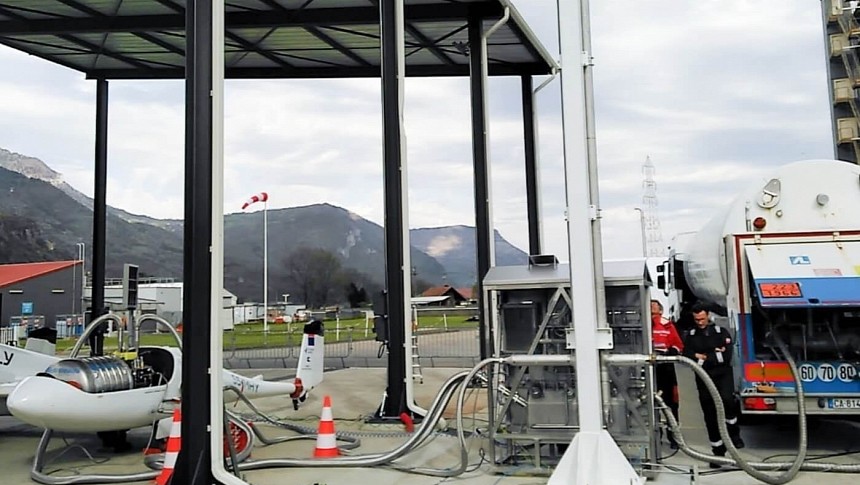With various electric aircraft almost ready to take off, the aviation industry is already looking at the next step towards emission-free commercial flights – hydrogen. The German-based H2Fly is quickly advancing its hydrogen-powered fuel cell powertrain.
Here is why you should know about H2Fly. It claims to hold the world altitude record for hydrogen aviation, after its aircraft, the HY4, managed to fly as high as 7,230 feet (2,203 meters).
It happened in 2022, in Germany, and followed another world-first for the same aircraft demonstrator, when it completed a 77-mile (124 km) flight between Stuttgart and Friedrichshafen. That was the first time when a passenger airplane flew between two commercial airports, powered by hydrogen.
These achievements didn’t come easy. The Stuttgart-based fuel cell expert has been working on this for over a decade. Its four-seat passenger aircraft, the HY4, took to the sky for the first time back in 2016. Four years later, the latest version of the HY4, equipped with a fully redundant powertrain, was given permission to fly, which marked a milestone for hydrogen aviation.
By the end of last year, H2Fly also announced the success of a newly-developed liquid hydrogen tank during initial tests. This was part of a large-scale European project, called HEAVEN, which brought together important names in the industry, including DLR (The German Aerospace Center), Pipistrel Vertical Solutions, and Air Liquide Advanced Technologies.
By the Fall of 2022, the liquid hydrogen tank developed by Air Liquide had passed vibration and leakage tests and then went on to successfully complete the integration stage.
This month, it hit another milestone in the form of successful on-ground filling tests. The demonstration was carried out at Sassenage, France. This is where the Air Liquide facility, Campus Technologies Grenoble, is located. During the tests, the two companies demonstrated refueling operations for the hydrogen tank, integrated onto the HY4 aircraft.
This is a huge step, but not the last one. Next, the storage system for liquid hydrogen will be coupled with a fuel cell system. Then, the company will kick off a major flight test campaign this summer.
H2Fly wants to have a regional aircraft demonstrator ready to take to the sky by 2025. This won’t be one that’s built from scratch for the hydrogen-electric powertrain, but a retrofitted one. H2Fly will work with the German manufacturer Deutsche Aircraft to convert a Dornier 328 for hydrogen operations.
The ultimate goal is to have the H2Fly fuel cell system certified by EASA ( the European Union Aviation Safety Agency) for large aircraft (the CS25). This will enable regional airliners to operate on medium and even long-distance routes using only hydrogen. It will take some time, but many believe that this is the path toward green flights.
It happened in 2022, in Germany, and followed another world-first for the same aircraft demonstrator, when it completed a 77-mile (124 km) flight between Stuttgart and Friedrichshafen. That was the first time when a passenger airplane flew between two commercial airports, powered by hydrogen.
These achievements didn’t come easy. The Stuttgart-based fuel cell expert has been working on this for over a decade. Its four-seat passenger aircraft, the HY4, took to the sky for the first time back in 2016. Four years later, the latest version of the HY4, equipped with a fully redundant powertrain, was given permission to fly, which marked a milestone for hydrogen aviation.
By the end of last year, H2Fly also announced the success of a newly-developed liquid hydrogen tank during initial tests. This was part of a large-scale European project, called HEAVEN, which brought together important names in the industry, including DLR (The German Aerospace Center), Pipistrel Vertical Solutions, and Air Liquide Advanced Technologies.
By the Fall of 2022, the liquid hydrogen tank developed by Air Liquide had passed vibration and leakage tests and then went on to successfully complete the integration stage.
This month, it hit another milestone in the form of successful on-ground filling tests. The demonstration was carried out at Sassenage, France. This is where the Air Liquide facility, Campus Technologies Grenoble, is located. During the tests, the two companies demonstrated refueling operations for the hydrogen tank, integrated onto the HY4 aircraft.
This is a huge step, but not the last one. Next, the storage system for liquid hydrogen will be coupled with a fuel cell system. Then, the company will kick off a major flight test campaign this summer.
H2Fly wants to have a regional aircraft demonstrator ready to take to the sky by 2025. This won’t be one that’s built from scratch for the hydrogen-electric powertrain, but a retrofitted one. H2Fly will work with the German manufacturer Deutsche Aircraft to convert a Dornier 328 for hydrogen operations.
The ultimate goal is to have the H2Fly fuel cell system certified by EASA ( the European Union Aviation Safety Agency) for large aircraft (the CS25). This will enable regional airliners to operate on medium and even long-distance routes using only hydrogen. It will take some time, but many believe that this is the path toward green flights.







